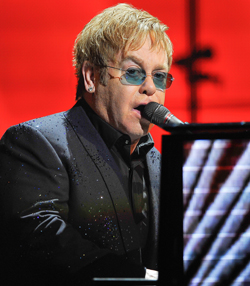
A 34-space, two-sided rack provides the real estate necessary for effects, which among a number of devices, includes a TC 2290 for vocal delay and Klipsch harmonizers for background vocals.
“While there’s a little ‘verb and harmonizer on the backing girls, I use a Lexicon 480L on Elton’s vocals,” Herr explains. “A LARC controller mounted atop my main console gives me control of the 480L, which I also use on piano. With the LARC’s presets I can quickly punch-up six or seven reverb times and delays and such, and on the piano I use a small hall setting that I don’t change at all – it’s just a set-it-and-forget it kind of thing.”
Among his inserts, Herr maintains five gates on Cooper’s tympani, and four more on his roto-toms. Still more gates spread across drummer Nigel Olsson’s kick and toms. Arriving on the scene courtesy of a collection of vintage dbx 160 comp/limiters, compression is used somewhat sparingly on vocals, bassist Matt Bissonette’s electric bass, and guitarist Davey Johnstone’s acoustic guitar.
“I really don’t rely on subgroups,” Herr says of his mix strategy. “All of my inputs hit the stereo bus and then I just break them up under the VCAs. The desk has 12 VCAs, that’s one of the reasons I wanted it for this show so much. I use 11 of them all the time – I send all the drums to one, the bass, guitars, Elton’s vocals, boys’ vocals, girls’ vocals to others, and so on down the line right through the cellos and percussion.”
While Herr is simpatico with the PM5000, he also had the opportunity to mix John on a new Yamaha CL Series digital console at the Yamaha 125th anniversary celebration held at Disney’s Hyperion Theatre during the recent NAMM Show in Anaheim.

“I enjoyed using the CL; in fact, when we have solo shows with Elton like this event, it will be my desk of choice,” Herr states. “The CL is very user friendly and sounded really good, in my opinion. The Neve inserts sounded fantastic; I used one of the compressors on Elton’s vocal. Normally, I use an outboard compressor, but this one worked quite well.”
The Million Dollar Piano’s input list takes a democratic approach to the matter of microphone selection, spanning its stage plot with everything from a hardwired Audio-Technica AE6100 at John’s vocal position to Sennheiser 421s at various points for drums and percussion, AKG 460 on ride cymbal, AKG 414s on overheads, Shure SM57s on snare top and bottom, and Beta 52 on kick.
Countryman was the DI of choice for bass and Bullard’s keys, while guitarist Davey Johnstone miked his electric guitar cabinets with both Sennheiser 409s and 609s, which are used selectively as needed.
Good Kind Of Loud
Four years went into the building of the highly-modified CFIIIS Yamaha grand piano that earned its Million Dollar name prior to Sir Elton simply calling it “Blossom.” A visual treat and sonic masterpiece, the instrument is equipped with its own video display on its audience side that manifests colorful graphics and imagery with amazing definition.

At any given moment, you may see anything from Versace-inspired designs to video footage of past performances and ambience-enhancing expressions matching adjacent scenery or lighting effects.
Pushing the scales at nearly 2,000 pounds, the Million Dollar Piano stays put at Caesars, moving in-and-out on a lift in accordance with his dates at The Colosseum. Four stereo MIDI modules – two of them active all the time – are used to create the huge sound that comes out of the instrument.
“With our MIDI configuration, I can really fatten up the sound when he lays into the keyboard with his left hand,” Herr says. “The sound is super tight and it hits you in the chest like a kick drum. If I spread my Eventide Eclipse harmonizer across it too, it gets even more impressive. The sound of the strings really comes out. You get so much more than what we all expect to hear from a piano, even if it is a million-dollar one.”
